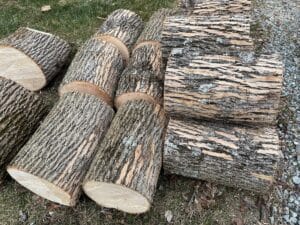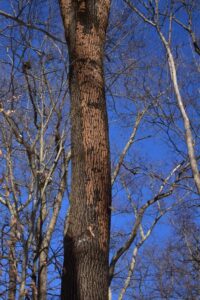Hello fellow readers, Last week’s chat about the end of the Emerald Ash Borer (EAB) quarantine brought quite a buzz. Though authorities will no longer restrict ash wood movement, we can help control Emerald Ash Borer spread by doing our part. Which brings the question of Robert of Hope NJ, “Should I remove all the ash trees on my property? And if so, what should I do with the wood?”
Remove only hazardous trees.
I’d consider removing only diseased trees that are a hazard, such as trees near the house, driveway, or street. Trees within ten to twenty feet of your road may be the town’s responsibility, so check with them first. Otherwise, be sure to hire an insured professional.
Removing trees yourself or hiring a handyman is too dangerous, having heard of far too many DIY injuries in the course of my work as a landscape designer. And if the tree service is uninsured and damage or injuries occur, homeowner’s insurance is unlikely to cover it. The same is true of landscape installations, by the way. Always ask whomever you hire for a copy of their certificate of insurance.
If your neighbors also have hazardous trees, perhaps you can hire a professional together and share the expense. There’s cost efficiency in mobilizing heavy equipment to take down several trees. And the wood doesn’t have to go to waste.
How to recycle EAB infested wood safely:
Tree services often take the wood away to recycle into mulch. EAB eggs or larvae won’t live in ground-up wood.
You can also use it as firewood, keeping it close to home to prevent spreading the invader. Ashwood is a hardwood that is easy to split and burns cleanly with few sparks. Some say it’s the best wood to burn.
Another question came from Debra of Bangor, PA, who has a cherished three-foot caliper ash tree, “Should I treat it before it becomes infected or after?”
Prevention of Emerald Ash Borer is best.
Ideally, treat your tree before EAB moves into town, they say within fifteen miles. Not to say you can’t save the tree if already impacted if the damage is less than fifty percent of the bark or canopy: the more impacted, the less likely a turnaround. Typically, injection treatments by a professional arborist need to be done every two years. And it’s costly.
As a point of reference, a nearby client with a similarly sized tree to Debra’s invested $1,200 for an EAB treatment “consisting of cambium injections of Emamectin Benzoate to provide a two-year residual protection,” per their arborist. (The cambium layer is the new growth area of the trunk. It’s inside the inner bark layer, aka phloem, where nutrients flow throughout the tree.) It’s not until all the untreated ash trees die before the Emerald Ash Borer moves on. Only then should you end the treatments.
About topical insecticides and biological controls of EAB
Unfortunately, it’s not usually practical to use topical insecticides, though far less costly. (You can learn more about Insecticide Options in the link below.) And while some studies since 2007 using predatorial wasps by the U.S. Department of Agriculture are encouraging, the continued spread of EAB speaks for itself.
I’d leave diseased ash trees in wooded areas as decaying or fallen trees provide wildlife habitat. And as dead trees decay, they fertilize the soil for a new generation of growth. I’ve read native trees such as red maple (Acer rubrum) are likely to populate forests where ash trees once stood. It’s the cycle of life, which brings a new beginning I’d like to share.

Meet Jolee, a rescue from Father John’s Animal House
We welcomed a new furry kid a week ago— a rescue adopted through Father John’s Animal House in Lafayette, NJ. Jolee is about five months old, brought up from Mississippi by a grassroots organization that saves strays there. She’s already filling the emptiness left behind by our dear Miss Ellie Mae, whose paw prints on our hearts will never end. It’s the cycle of life.
Garden Dilemmas? AskMaryStone@gmail.com (and now on your favorite Podcast App.)
Click through to the previous column Emerald Ash Borer a Lost Cause?
and a heartfelt column about Father John’s Animal House Garden
Helpful Links:
More about Biological Controls and Insecticide Options for Protecting Ash Trees from Emerald Ash Borer




